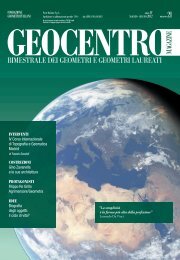Geocentro Magazine - Fondazione Geometri
Geocentro Magazine - Fondazione Geometri
Geocentro Magazine - Fondazione Geometri
Create successful ePaper yourself
Turn your PDF publications into a flip-book with our unique Google optimized e-Paper software.
L’avvento della stampa diffonde ancor più le conoscenze<br />
di questi pionieri della nuova cartografia geometrica e si<br />
registra nel giro di poche decine di anni la pubblicazione<br />
di vari trattati di Topografia, o <strong>Geometri</strong>a pratica, tra i<br />
quali spiccano l’opera di Cosimo Bartoli, che pubblica nel<br />
1564 una summa delle conoscenze nel campo, riunendo in<br />
un volume dal titolo Del modo di misurare le distantie, le<br />
superficie, i corpi, le piante, le prouincie, le prospettive, e tutte<br />
le altre cose terrene, che possono occorrere a gli uomini, secondale<br />
uere regole d’Euclide, e de gli altri più lodati scrittori, tutte le<br />
tecniche conosciute fino ai suoi giorni, e l’opera di Silvio<br />
Belli, dal titolo Libro del mesurar con la vista, del 1566, nel<br />
quale viene tra l’altro illustrato un metodo di rilevamento<br />
grafico, che anticipa quello sul quale si fonderà poi l’uso<br />
della tavoletta pretoriana. (vedi pag. 53)<br />
Il quadro scientifico di riferimento sembra a questo punto<br />
completo, sia per quanto attiene al rilevamento, sia per<br />
quanto riguarda le modalità di restituzione grafica, ma<br />
nonostante tutto ciò, la cartografia geometrica come<br />
nuovo genere stenta ancora ad affermarsi definitivamente,<br />
risentendo ancora per decenni di un approccio imitativo,<br />
condizionato anche dai prevalenti canoni estetici del tempo,<br />
che alle innaturali visioni zenitali delle città e del territorio<br />
lasciano preferire forme ibride di rappresentazione, tra la<br />
visione in pianta e le consuete immagini di paesaggio.<br />
Per le piante, per le carte corografiche e per quelle topografiche<br />
sembra in sintesi delinearsi uno scenario limitante, che<br />
le relega ai soli ambienti degli specialisti, quasi al livello<br />
di schizzi preparatori, tramiti, elementi intermedi per la<br />
costruzione di pitture di paesaggio, di scorci prospettici, di<br />
vedute a volo d’uccello.<br />
Rosa dei venti<br />
Compass rose<br />
in 1564 as a summa of surveying knowledge of the time: all<br />
the methods well known up to his days. Another milestone in<br />
the cartographical field is the essay by Silvio Belli Libro del<br />
mesurar con la vista, 1566, where, among other things, a new<br />
method of graphic surveying is introduced, ahead of the one<br />
that is at the basis of the use of the plane table.<br />
As it is, the theoretical background seems now complete, both<br />
for what concerns the practical surveying, and the graphic<br />
representation. Nevertheless, the new gender of the geometrical<br />
cartography still finds it hard to impose itself. At least as long<br />
as a few decades, an imitational approach was preferred, even<br />
thanks to the prevailing aesthetic criteria of the time that<br />
preferred mixed kinds of representation (in between the map<br />
and the landscape view) to the unrealistic zenith-based sketches<br />
of towns and lands.<br />
The future destiny of all the plans, the chorographical and<br />
topographical maps seems to be uncertain: their relevance is<br />
such only among the specialists; there are considered a sort of<br />
preliminary sketches that can represent the intermediary towards<br />
landscape painting, perspective sights, and bird’s eye views.<br />
We still have interesting proofs of this process. Among the<br />
others, the famous “Florentia” (“View of the chain”), ascribed<br />
to Francesco Rosselli; the notorious view of Venice by Jacopo de’<br />
Barbari, and the fresco “View of Florence during the siege of<br />
1530”, in Florence’s Palazzo Vecchio by Vasari. All of them are<br />
realised following previous topographical surveys of the town<br />
scale, thereafter elaborated through different perspective rules.<br />
What makes the change?<br />
Why such a kind of document became popular in the Renaissance<br />
cultural background?<br />
How was it possible the shift to a new way of conceiving the<br />
57






